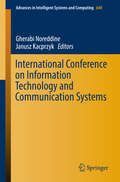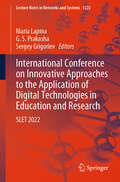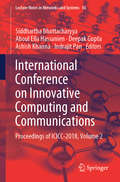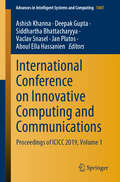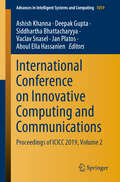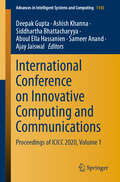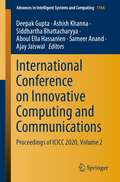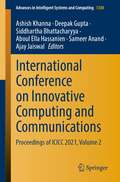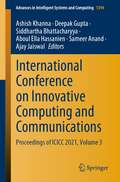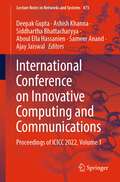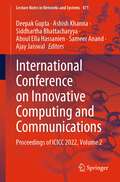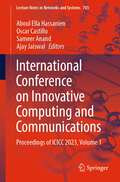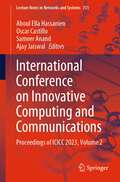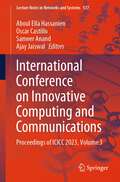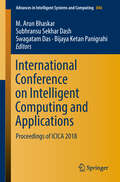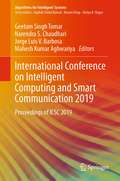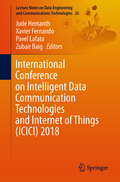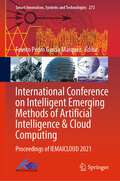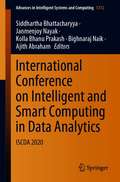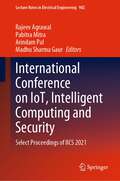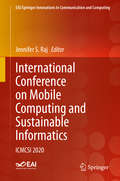- Table View
- List View
International Conference on Information Technology and Communication Systems
by Janusz Kacprzyk Gherabi NoreddineThis book reports on advanced methods and theories in two related fields of research, Information Technology and Communication Systems. It provides professors, scientists, PhD students and engineers with a readily available guide to various approaches in Engineering Science. The book is divided into two major sections, the first of which covers Information Technology topics, including E-Learning, E-Government (egov), Data Mining, Text Mining, Ontologies, Semantic Similarity Databases, Multimedia Information Processing, and Applications. The second section addresses Communication Systems topics, including: Systems, Wireless and Network Computing, Software Security and Monitoring, Modern Antennas, and Smart Grids. The book gathers contributions presented at the International Conference on Information Technology and Communication Systems (ITCS 2017) held at the National School of Applied Sciences of Khouribga, Hassan 1st University, Morocco on March 28-29, 2017. This event was organized with the objective of bringing together researchers, developers, and practitioners from academia and industry working in all areas of Information Technology and Communication Systems. It not only highlights new methods, but also promotes collaborations between different communities working on related topics.
International Conference on Innovative Approaches to the Application of Digital Technologies in Education and Research: SLET 2022 (Lecture Notes in Networks and Systems #1222)
by G. S. Prakasha Maria Lapina Sergey GrigorievThis book is based on the best papers accepted for presentation during the SLET-2022: International Conference on Innovative Approaches to the Application of Digital Technologies in Education and Research. The book includes research on digital pedagogy, e-learning technologies, end-to-end technologies in education, and educational transformation. The contributions in this volume highlight the significant advancements and innovative methodologies in digital education. The book provides a consolidated research exploration on contemporary themes in education such as digital teaching technologies, digital pedagogy and resources, gamification, and innovations in education with a special focus on educational technology for present and future educators. The authors of these papers have explored diverse topics, such as artificial intelligence in education, the integration of virtual and augmented reality, the development of online learning platforms, and the impact of digital tools on student engagement and learning outcomes. This collection aims to provide educators, researchers, and practitioners with insights into the latest trends and challenges in digital education. It also seeks to inspire further research and innovation in applying digital technologies to enhance teaching and learning experiences. As the landscape of education continues to evolve, the integration of digital technologies becomes increasingly critical. This book addresses a wide range of issues and opportunities, offering valuable perspectives on how digital tools can be leveraged to improve educational outcomes and accessibility. This book serves as a vital resource for comprehending the future of education and the transformative role digital technologies play in its development. By delving into the innovative approaches and cutting-edge research presented within, readers gain a deeper understanding of how digital advancements are redefining educational practices and enhancing learning experiences. The insights provided in this volume help educators develop more effective teaching strategies, incorporate new technologies into their curricula, and ultimately create more engaging and inclusive learning environments. Moreover, the book intends to foster new ideas, discussions, and collaborations that will continue to advance educational technology, thus bringing together a diverse array of research and perspectives to encourage a multidisciplinary approach to solving the complex challenges facing modern education.
International Conference on Innovative Computing and Communications: Proceedings Of Icicc 2018, Volume 2 (Lecture Notes in Networks and Systems #56)
by Siddhartha Bhattacharyya Aboul Ella Hassanien Indrajit Pan Deepak Gupta Ashish KhannaThe book includes high-quality research papers presented at the International Conference on Innovative Computing and Communication (ICICC 2018), which was held at the Guru Nanak Institute of Management (GNIM), Delhi, India on 5–6 May 2018. Introducing the innovative works of scientists, professors, research scholars, students and industrial experts in the field of computing and communication, the book promotes the transformation of fundamental research into institutional and industrialized research and the conversion of applied exploration into real-time applications.
International Conference on Innovative Computing and Communications: Proceedings of ICICC 2018, Volume 2 (Lecture Notes in Networks and Systems #56)
by Siddhartha Bhattacharyya Aboul Ella Hassanien Indrajit Pan Deepak Gupta Ashish KhannaThe book includes high-quality research papers presented at the International Conference on Innovative Computing and Communication (ICICC 2018), which was held at the Guru Nanak Institute of Management (GNIM), Delhi, India on 5–6 May 2018. Introducing the innovative works of scientists, professors, research scholars, students and industrial experts in the field of computing and communication, the book promotes the transformation of fundamental research into institutional and industrialized research and the conversion of applied exploration into real-time applications.
International Conference on Innovative Computing and Communications: Proceedings of ICICC 2019, Volume 1 (Advances in Intelligent Systems and Computing #1087)
by Vaclav Snasel Siddhartha Bhattacharyya Aboul Ella Hassanien Deepak Gupta Ashish Khanna Jan PlatosThis book includes high-quality research papers presented at the Second International Conference on Innovative Computing and Communication (ICICC 2019), which is held at the VŠB - Technical University of Ostrava, Czech Republic, on 21–22 March 2019. Introducing the innovative works of scientists, professors, research scholars, students, and industrial experts in the fields of computing and communication, the book promotes the transformation of fundamental research into institutional and industrialized research and the conversion of applied exploration into real-time applications.
International Conference on Innovative Computing and Communications: Proceedings of ICICC 2019, Volume 2 (Advances in Intelligent Systems and Computing #1059)
by Vaclav Snasel Siddhartha Bhattacharyya Aboul Ella Hassanien Deepak Gupta Ashish Khanna Jan PlatosThis book gathers high-quality research papers presented at the Second International Conference on Innovative Computing and Communication (ICICC 2019), which was held at the VSB - Technical University of Ostrava, Czech Republic, on 21–22 March 2019. Highlighting innovative papers by scientists, scholars, students, and industry experts in the fields of computing and communication, the book promotes the transformation of fundamental research into institutional and industrialized research, and the translation of applied research into real-world applications.
International Conference on Innovative Computing and Communications: Proceedings of ICICC 2020, Volume 1 (Advances in Intelligent Systems and Computing #1165)
by Siddhartha Bhattacharyya Aboul Ella Hassanien Deepak Gupta Ashish Khanna Sameer Anand Ajay JaiswalThis book includes high-quality research papers presented at the Third International Conference on Innovative Computing and Communication (ICICC 2020), which is held at the Shaheed Sukhdev College of Business Studies, University of Delhi, Delhi, India, on 21–23 February, 2020. Introducing the innovative works of scientists, professors, research scholars, students and industrial experts in the field of computing and communication, the book promotes the transformation of fundamental research into institutional and industrialized research and the conversion of applied exploration into real-time applications.
International Conference on Innovative Computing and Communications: Proceedings of ICICC 2020, Volume 2 (Advances in Intelligent Systems and Computing #1166)
by Siddhartha Bhattacharyya Aboul Ella Hassanien Deepak Gupta Ashish Khanna Sameer Anand Ajay JaiswalThis book includes high-quality research papers presented at the Third International Conference on Innovative Computing and Communication (ICICC 2020), which is held at the Shaheed Sukhdev College of Business Studies, University of Delhi, Delhi, India, on 21–23 February, 2020. Introducing the innovative works of scientists, professors, research scholars, students and industrial experts in the field of computing and communication, the book promotes the transformation of fundamental research into institutional and industrialized research and the conversion of applied exploration into real-time applications.
International Conference on Innovative Computing and Communications: Proceedings of ICICC 2021, Volume 1 (Advances in Intelligent Systems and Computing #1387)
by Siddhartha Bhattacharyya Aboul Ella Hassanien Deepak Gupta Ashish Khanna Sameer Anand Ajay JaiswalThis book includes high-quality research papers presented at the Fourth International Conference on Innovative Computing and Communication (ICICC 2021), which is held at the Shaheed Sukhdev College of Business Studies, University of Delhi, Delhi, India, on February 20–21, 2021. Introducing the innovative works of scientists, professors, research scholars, students and industrial experts in the field of computing and communication, the book promotes the transformation of fundamental research into institutional and industrialized research and the conversion of applied exploration into real-time applications.
International Conference on Innovative Computing and Communications: Proceedings of ICICC 2021, Volume 2 (Advances in Intelligent Systems and Computing #1388)
by Siddhartha Bhattacharyya Aboul Ella Hassanien Deepak Gupta Ashish Khanna Sameer Anand Ajay JaiswalThis book includes high-quality research papers presented at the Fourth International Conference on Innovative Computing and Communication (ICICC 2021), which is held at the Shaheed Sukhdev College of Business Studies, University of Delhi, Delhi, India, on February 20–21, 2021. Introducing the innovative works of scientists, professors, research scholars, students and industrial experts in the field of computing and communication, the book promotes the transformation of fundamental research into institutional and industrialized research and the conversion of applied exploration into real-time applications.
International Conference on Innovative Computing and Communications: Proceedings of ICICC 2021, Volume 3 (Advances in Intelligent Systems and Computing #1394)
by Siddhartha Bhattacharyya Aboul Ella Hassanien Deepak Gupta Ashish Khanna Sameer Anand Ajay JaiswalThis book includes high-quality research papers presented at the Fourth International Conference on Innovative Computing and Communication (ICICC 2021), which is held at the Shaheed Sukhdev College of Business Studies, University of Delhi, Delhi, India, on February 20–21, 2021. Introducing the innovative works of scientists, professors, research scholars, students and industrial experts in the field of computing and communication, the book promotes the transformation of fundamental research into institutional and industrialized research and the conversion of applied exploration into real-time applications.
International Conference on Innovative Computing and Communications: Proceedings of ICICC 2022, Volume 1 (Lecture Notes in Networks and Systems #473)
by Siddhartha Bhattacharyya Aboul Ella Hassanien Deepak Gupta Ashish Khanna Sameer Anand Ajay JaiswalThis book includes high-quality research papers presented at the Fifth International Conference on Innovative Computing and Communication (ICICC 2022), which is held at the Shaheed Sukhdev College of Business Studies, University of Delhi, Delhi, India, on February 19–20, 2022. Introducing the innovative works of scientists, professors, research scholars, students and industrial experts in the field of computing and communication, the book promotes the transformation of fundamental research into institutional and industrialized research and the conversion of applied exploration into real-time applications.
International Conference on Innovative Computing and Communications: Proceedings of ICICC 2022, Volume 2 (Lecture Notes in Networks and Systems #471)
by Siddhartha Bhattacharyya Aboul Ella Hassanien Deepak Gupta Ashish Khanna Sameer Anand Ajay JaiswalThis book includes high-quality research papers presented at the Fifth International Conference on Innovative Computing and Communication (ICICC 2022), which is held at the Shaheed Sukhdev College of Business Studies, University of Delhi, Delhi, India, on February 19–20, 2022. Introducing the innovative works of scientists, professors, research scholars, students and industrial experts in the field of computing and communication, the book promotes the transformation of fundamental research into institutional and industrialized research and the conversion of applied exploration into real-time applications.
International Conference on Innovative Computing and Communications: Proceedings of ICICC 2022, Volume 3 (Lecture Notes in Networks and Systems #492)
by Aboul Ella Hassanien Deepak Gupta Ashish Khanna Sameer Anand Ajay JaiswalThis book includes high-quality research papers presented at the Fifth International Conference on Innovative Computing and Communication (ICICC 2022), which is held at the Shaheed Sukhdev College of Business Studies, University of Delhi, Delhi, India, on February 19–20, 2022. Introducing the innovative works of scientists, professors, research scholars, students and industrial experts in the field of computing and communication, the book promotes the transformation of fundamental research into institutional and industrialized research and the conversion of applied exploration into real-time applications.
International Conference on Innovative Computing and Communications: Proceedings of ICICC 2023, Volume 1 (Lecture Notes in Networks and Systems #703)
by Oscar Castillo Aboul Ella Hassanien Sameer Anand Ajay JaiswalThis book includes high-quality research papers presented at the Sixth International Conference on Innovative Computing and Communication (ICICC 2023), which is held at the Shaheed Sukhdev College of Business Studies, University of Delhi, Delhi, India, on February 17–18, 2023. Introducing the innovative works of scientists, professors, research scholars, students and industrial experts in the field of computing and communication, the book promotes the transformation of fundamental research into institutional and industrialized research and the conversion of applied exploration into real-time applications.
International Conference on Innovative Computing and Communications: Proceedings of ICICC 2023, Volume 2 (Lecture Notes in Networks and Systems #731)
by Oscar Castillo Aboul Ella Hassanien Sameer Anand Ajay JaiswalThis book includes high-quality research papers presented at the Sixth International Conference on Innovative Computing and Communication (ICICC 2023), which is held at the Shaheed Sukhdev College of Business Studies, University of Delhi, Delhi, India, on February 17–18, 2023. Introducing the innovative works of scientists, professors, research scholars, students, and industrial experts in the field of computing and communication, the book promotes the transformation of fundamental research into institutional and industrialized research and the conversion of applied exploration into real-time applications.
International Conference on Innovative Computing and Communications: Proceedings of ICICC 2023, Volume 3 (Lecture Notes in Networks and Systems #537)
by Oscar Castillo Aboul Ella Hassanien Sameer Anand Ajay JaiswalThis book includes high-quality research papers presented at the Sixth International Conference on Innovative Computing and Communication (ICICC 2023), which is held at the Shaheed Sukhdev College of Business Studies, University of Delhi, Delhi, India, on February 17–18, 2023. Introducing the innovative works of scientists, professors, research scholars, students, and industrial experts in the field of computing and communication, the book promotes the transformation of fundamental research into institutional and industrialized research and the conversion of applied exploration into real-time applications.
International Conference on Intelligent Computing and Applications: Proceedings of ICICA 2018 (Advances in Intelligent Systems and Computing #846)
by Bijaya Ketan Panigrahi Swagatam Das Subhransu Sekhar Dash M. Arun BhaskarThe book is a collection of best papers presented at the International Conference on Intelligent Computing and Applications (ICICA 2018), held at Velammal Engineering College, Chennai, India on 2–3 February 2018. Presenting original work in the field of computational intelligence and power and computing technology, it focuses on soft computing applications in power systems; power-system modeling and control; FACTS devices – applications in power systems; power-system stability and switchgear and protection; power quality issues and solutions; smart grids; green and renewable energy technologies; optimization techniques in electrical systems; power electronics controllers for power systems; power converters and modeling; high voltage engineering; diagnosis and sensing systems; and robotics.
International Conference on Intelligent Computing and Smart Communication 2019: Proceedings of ICSC 2019 (Algorithms for Intelligent Systems)
by Narendra S. Chaudhari Geetam Singh Tomar Jorge Luis V. Barbosa Mahesh Kumar AghwariyaThis book gathers high-quality research papers presented at the First International Conference, ICSC 2019, organised by THDC Institute of Hydropower Engineering and Technology, Tehri, India, from 20 to 21 April 2019. The book is divided into two major sections – Intelligent Computing and Smart Communication. Some of the areas covered are Parallel and Distributed Systems, Web Services, Databases and Data Mining Applications, Feature Selection and Feature Extraction, High-Performance Data Mining Algorithms, Knowledge Discovery, Communication Protocols and Architectures, High-speed Communication, High-Voltage Insulation Technologies, Fault Detection and Protection, Power System Analysis, Embedded Systems, Architectures, Electronics in Renewable Energy, CAD for VLSI, Green Electronics, Signal and Image Processing, Pattern Recognition and Analysis, Multi-Resolution Analysis and Wavelets, 3D and Stereo Imaging, and Neural Networks.
International Conference on Intelligent Data Communication Technologies and Internet of Things (Lecture Notes on Data Engineering and Communications Technologies #26)
by Jude Hemanth Xavier Fernando Zubair Baig Pavel LafataThis book discusses data communication and computer networking, communication technologies and the applications of IoT (Internet of Things), big data, cloud computing and healthcare informatics. It explores, examines and critiques intelligent data communications and presents inventive methodologies in communication technologies and IoT. Aimed at researchers and academicians who need to understand the importance of data communication and advanced technologies in IoT, it offers different perspectives to help readers increase their knowledge and motivates them to conduct research in the area, highlighting various innovative ideas for future research.
International Conference on Intelligent Emerging Methods of Artificial Intelligence & Cloud Computing: Proceedings of IEMAICLOUD 2021 (Smart Innovation, Systems and Technologies #273)
by Fausto Pedro García MárquezThis book consists of different accepted papers of the conference. Firstly, the artificial intelligence and its application-related topics are provided. Secondly, cloud computing and related topics are also provided. The book has been designed to help research organisations and business leaders from across industries to transform their organisations into AI-driven disruptors. The utility of the technology in the face of massive globally interconnected complexity is explored. The significant characteristics of IEMAICLOUD are the promotion of inevitable dialogue between scientists, researchers, engineers, corporate’s and scholar’s students to mitigate the gap between academia, industry and governmental ethics which has been fostered through keynote speeches, workshops, panel discussion and oral presentations by eminent researchers in relevant field. The industry personnel depict cutting-edge researches in artificial intelligence and cloud computing to convey academia regarding real-time scenario and practical findings. Conference has been well equipped with talks by industry experts on the state of the art in computer science, lectures by eminent scientists designed to inspire and inform presentations by innovative researchers coming from 20+ countries from Europe and abroad. There has been discussion-oriented sessions and networking breaks to enable collaborations. Papers consist abstract, result, discussions and conclusions by the help of different tables and diagrams.
International Conference on Intelligent and Smart Computing in Data Analytics: ISCDA 2020 (Advances in Intelligent Systems and Computing #1312)
by Ajith Abraham Siddhartha Bhattacharyya Janmenjoy Nayak Bighnaraj Naik Kolla Bhanu PrakashThis book is a collection of best selected research papers presented at International Conference on Intelligent and Smart Computing in Data Analytics (ISCDA 2020), held at K L University, Guntur, Andhra Pradesh, India. The primary focus is to address issues and developments in advanced computing, intelligent models and applications, smart technologies and applications. It includes topics such as artificial intelligence and machine learning, pattern recognition and analysis, computational intelligence, signal and image processing, bioinformatics, ubiquitous computing, genetic fuzzy systems, hybrid evolutionary algorithms, nature-inspired smart hybrid systems, Internet of things, industrial IoT, health informatics, human–computer interaction and social network analysis. The book presents innovative work by leading academics, researchers and experts from industry.
International Conference on IoT, Intelligent Computing and Security: Select Proceedings of IICS 2021 (Lecture Notes in Electrical Engineering #982)
by Pabitra Mitra Rajeev Agrawal Madhu Sharma Gaur Arindam PalThis book comprises select peer-reviewed papers from the International Conference on IoT, Intelligent Computing and Security, IICS 2021. The contents focus on the latest research in artificial intelligence, IoT, intelligent computing, and leading technological convergence security challenges. The book also discusses AI-driven automation of highly connected smart devices across the globe presenting the fast technological shift with the futuristic scenario, bursting perspective of IoT, computational intelligence, and security concerns. This book supports the transfer of vital knowledge to the next generation of researchers, students, and practitioners in academia and industry.
International Conference on Managing Business Through Web Analytics
by Soraya Sedkaoui Mounia Khelfaoui Rafika Benaichouba Khalida Mohammed BelkebirThis book presents the proceedings of the International Conference on Managing Business through Web Analytics (ICMBWA 2021). The conference provides a global forum for sharing knowledge and results in theory, methodology, and applications of Web Analytics and their role in the formulation and the orientation of businesses’ strategies. The aim of the conference is to provide a platform for researchers and practitioners from both academia and industry to meet and share their works in the field. Is an excellent resource for scholars, experts and industrial in the fields represented, as well as Ph.D. students seeking an entryway into current research in data analytics, Web analytics, machine learning algorithms, and their various applications within businesses.
International Conference on Mobile Computing and Sustainable Informatics: ICMCSI 2020 (EAI/Springer Innovations in Communication and Computing)
by Jennifer S. RajSustainability and mobile computing embraces a wide range of Information and Communication Technologies [ICT] in recent times. This book focuses more on the recent research and development works in almost all the facets of sustainable, ubiquitous computing and communication paradigm. The recent research efforts on this evolving paradigm help to advance the technologies for next-generation, where socio-economic growth and sustainability poses significant challenges to the computing and communication infrastructures. The main purpose of this book is to promote the technical advances and impacts of sustainability and mobile computing to the informatics research. The key strands of this book include green computing, predictive models, mobility, data analytics, mobile computing, optimization, Quality of Service [QoS], new communicating and computing frameworks, human computer interaction, Artificial Intelligence [AI], communication networks, risk management, Ubiquitous computing, robotics, smart city and applications. The book has also addressed myriad of sustainability challenges in various computing and information processing infrastructures.
